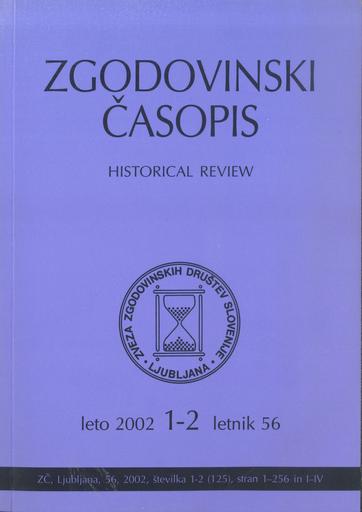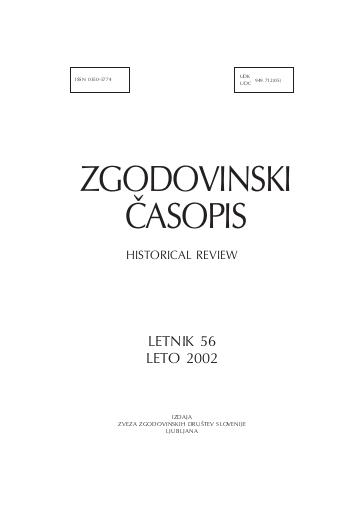/
Periodicals
/
Zgodovinski časopis
... quae terram nostram et Regnum Hungariae dividit ...
Development of the border of the Empire in lower Carniola in the Middle Ages

Author(s):Miha Kosi
Co-author(s):Peter Štih (odg. ur.)
Year:2002
Publisher(s):Zveza zgodovinskih društev Slovenije, Ljubljana
Source(s):Zgodovinski časopis, 2002, št. 1-2
Language(s):slovenščina
Type(s) of material:text
Keywords:Sveto rimsko cesarstvo, meje, Dolenjska (Slovenija), srednji vek, Holy Roman Empire, borders, Dolenjska (Slovenia), Middle Ages
Rights:

This work by Miha Kosi is licensed under Creative Commons Attribution-NonCommercial-ShareAlike 4.0 International
Files (1)

Name:ZC_1-2_-_2002.pdf
Size:16.51MB
Format:application/pdf
Permanent link:https://hdl.handle.net/11686/file43
Description
Medieval border of German Empire between Lower Carniola (Kranjska) and Slavonia is the result of a lengthy process between the second half of the 10th and 13th centuries. By colonising the border forest and the Gorjanci-Žumberk hills the imperial border shifted from the approximate line along the Krka river over twenty kilometers to the southeast. The annexation of the new territory had been carried out mainly by the Carinthian dukes of Spanheim, the counts of Weichselburg and by the bishops of Freising and countsof Bogen with their ministerials. The new borderline was from the 13th century onwards defined by the castles and estates Gračeno, Žumberk (Sicherberg), Sicherstein, Vivodina (Herzogtum) and Metlika (Mötling). This border remained fixed until the 16th century when the Turkish raids caused an economic collapse and considerable ethnic changes. A wide border zone, settled by the refugees from the Balkans (Uskoki), became part of the Military Frontier (Vojna krajina). In the 18th century the border of Carniola was shifted back to the ridge of Gorjanci where from the dissolution of Vojna krajina (1881) up to the present day it has formed the new border with Croatia.
Metadata (12)
- identifierhttps://hdl.handle.net/11686/5319
- title
- ...quae terram nostram et Regnum Hungariae dividit...
- Razvoj meje cesarstva na Dolenjskem v srednjem veku
- ... quae terram nostram et Regnum Hungariae dividit ...
- Development of the border of the Empire in lower Carniola in the Middle Ages
- creator
- Miha Kosi
- contributor
- Peter Štih (odg. ur.)
- subject
- Sveto rimsko cesarstvo
- meje
- Dolenjska (Slovenija)
- srednji vek
- Holy Roman Empire
- borders
- Dolenjska (Slovenia)
- Middle Ages
- description
- Medieval border of German Empire between Lower Carniola (Kranjska) and Slavonia is the result of a lengthy process between the second half of the 10th and 13th centuries. By colonising the border forest and the Gorjanci-Žumberk hills the imperial border shifted from the approximate line along the Krka river over twenty kilometers to the southeast. The annexation of the new territory had been carried out mainly by the Carinthian dukes of Spanheim, the counts of Weichselburg and by the bishops of Freising and countsof Bogen with their ministerials. The new borderline was from the 13th century onwards defined by the castles and estates Gračeno, Žumberk (Sicherberg), Sicherstein, Vivodina (Herzogtum) and Metlika (Mötling). This border remained fixed until the 16th century when the Turkish raids caused an economic collapse and considerable ethnic changes. A wide border zone, settled by the refugees from the Balkans (Uskoki), became part of the Military Frontier (Vojna krajina). In the 18th century the border of Carniola was shifted back to the ridge of Gorjanci where from the dissolution of Vojna krajina (1881) up to the present day it has formed the new border with Croatia.
- Srednjeveška meja cesarstva proti hrvaški Slavoniji na južnem Kranjskem je rezultat večstoletnega procesa, ki je potekal med drugo polovico 10. in 13. stoletjem. S kolonizacijo obsežnega mejnega gozda in hribovja Gorjancev - Žumberka se je meja imperija premaknila s približne linije na reki Krki več kot 20 kilometrov proti jugovzhodu. Priključitev novega teritorija so izpeljali koroški vojvode Spanheimi, škofje iz Freisinga, grofje Višnjegorski (von Weichselburg) ter grofje Bogenski s svojimi ministeriali. V 13. stoletju uveljavljeno mejno črto so določali gozdovi in gospostva Gračeno, Žumberk (Sicherberg), Sicherstein, Vivodina (Herzogtum) in Metlika (Mötling). Takšen potek meje je bil stabilen od 13. do 16. stoletja, ko so turški vpadi zrušili gospodarsko strukturo in povzročili etnične spremembe. Širok pas obmejnega območja je bil poseljen z Uskoki in vključen v Vojno krajino. Nova mejna črta s Hrvaško je bila v 18. stoletju umaknjena nazaj na sleme Gorjancev. Tukaj še danes tvori državno mejo Slovenije s Hrvaško.
- publisher
- Zveza zgodovinskih društev Slovenije
- date
- 2002
- type
- besedilo
- language
- Slovenščina
- isPartOf
- rights
- license: ccByNcSa
Citirano v (2)
| Tipologija | Avtor(ji) | Naslov | Kraj | Založba | Leto |
|---|---|---|---|---|---|
| 1.01 Izvirni znanstveni članek | Banić, Josip | The mystery of Merania : a new solution to old problems (Holy Roman Empire and the Kingdom of Croatia-Dalmatia during the investiture controversy). Part 2 | Ljubljana | Zveza zgodovinskih društev Slovenije | 2021 |
| 1.01 Izvirni znanstveni članek | Kočevar, Vanja | Ali je slovenska etnična identiteta obstajala v prednacionalni dobi? : kolektivne identitete in amplitude pomena etničnosti v zgodnjem novem veku | Ljubljana | Zveza zgodovinskih društev Slovenije | 2020 |
